Debra H. Goldstein's Blog, page 8
November 6, 2023
Noir at the Bar – Pepper Place
The Red Cat Coffeehouse@Pepper Place
February 24, 2024 – 6 p.m. CST
Eleven authors + music = a fun Noir at the Bar night. Sponsored by Red Cat Coffeehouse, Cat-n-Bird Winery, The Lumbar Restaurant and DeeDee’s Book Rack, the event will take place at the Red Cat Coffeehouse @Pepper Place, 2901 2nd Ave S #125, Birmingham, AL 35223. Authors reading will include Brian Panowich, Rebecca Forster, Emily Carpenter, Peter Farris, Hayley M. Moon, Liz Lazarus, Bobby Mathews, Jack Sharman, Meagan Lucas, Debra H. Goldstein, and Randy Moon.
The post Noir at the Bar – Pepper Place first appeared on Debra H. Goldstein.
The post Noir at the Bar – Pepper Place appeared first on Debra H. Goldstein.
Cozy Mystery Party Holiday Take – Over Event
December 16, 2023 – 11:30 a.m. – 12:00 p.m. EST
From December 15 thru December 17, 2023, fifty plus cozy authors will participate in this year’s Cozy Mystery Party Holiday Take-Over Event. There will be giveaways and discussion opportunities. Debra’s time is December 16, 2023 from 11:30 a.m. – 12:00 p.m. EST.
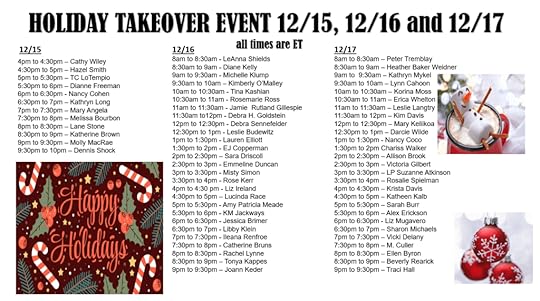
The post Cozy Mystery Party Holiday Take – Over Event first appeared on Debra H. Goldstein.
The post Cozy Mystery Party Holiday Take – Over Event appeared first on Debra H. Goldstein.
Branching Out? By Rosalie Spielman
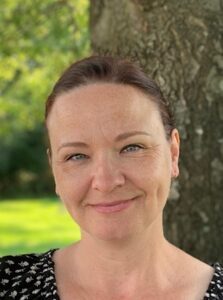 Thank you, Debra, for hosting me!
Thank you, Debra, for hosting me!
I am one happy gal in the fall. Like many of you, I adore autumn—the leaves, the crisp air, the scent of spices in the air and in the pastries, sweaters and cozy socks… One of the additional things I love is seeing the trees being stripped bare.
Don’t get me wrong, I love leaves. I have leaf motifs all over my house. But I also love studying the way tree branches are formed, and that is easier done when the branches are bare.
The randomness of tree branches fascinates me. One goes here, separates into two here, then two more, stretching outward—or inward—in a completely random non-pattern, creating this beautiful botanical creature. I almost like trees better in this form. Another example of nature being amazing.
As I study the tree outside my window, I imagine that each branch is a different writer, with their own jagged path and moments of decision that could lead them this way or that way. Two authors could start in the exact same place, and end up with wildly different results. It is impossible to know where decisions will lead, and all branches are growing, stretching further.
Of course, the branches splitting into new ones can happen at any time. That’s one of the interesting things about the cozy mystery subgenre in particular. Writers of cozies can do all of the different options, even simultaneously. I know writers who have agents who land them with larger publishing houses, but choose to also use smaller publishers, or self-publish, and some unagented writers who work with multiple publishers. The landscape is wide open in this genre.
I am where I am based on my decisions. Now I just have to figure out which little idea bud—or buds—to follow next! Do I write a historical cozy, or a traditional mystery? Do I write a cozy set in a pie shop, or a paranormal? Or—the most exciting option—do I do all of them? Only time will tell which branches will sprout successfully, possibly leading to more intersections.
Rosalie Spielman is a mother, veteran, and retired military spouse. She was thrilled to discover
that she could make other people laugh with her writing and finds joy in giving people a humorous escape from the real world. She writes cozy mysteries for the multi-author Aloha Lagoon mystery series and her own Hometown Mystery series, both with Gemma Halliday Publishing.
She currently lives in Maryland with her husband in a rapidly emptying nest. For more
information on her books or to subscribe to her newsletter, go to www.rosalie-spielman-author.com, follow her Facebook page (Rosalie Spielman author), or join her Facebook group, You know the Spiel! Rosalie strives to provide you a cozy escape...one page at a time.
Rosalie has two releases this fall:
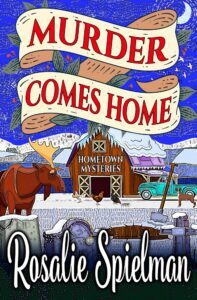
7 November 2023: #3 in the Hometown Mysteries, Murder Comes Home
Preorder: https://www.amazon.com/dp/B0C9S126XG
**Gemma Halliday Publishing is donating a portion of the presales to a veterans' charity, the Disabled American Veterans, or DAV.
US Army retiree Tessa Treslow and her Aunt Edna put their auto restoration business on hold to host an "American Pickers"-style TV show, hoping their trash might be treasure to fund their new business. But not only do the pickers come with cameras and likeable stars, but a murderer…
3 October 2023: #20 in the Aloha Lagoon mystery series, Hallo-waiian Murder Mystery
https://bookshop.org/a/97908/9798862110265
Aloha Lagoon's own dive tour leader Kiki Hepburn investigates the untimely death of one of her landlady Auntie Akamai's oldest friends in between diving, attending a zombie wedding, and being stalked by a "monster"!
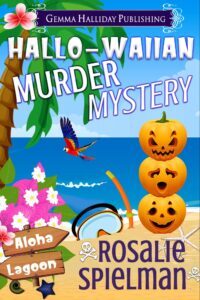
The post Branching Out? By Rosalie Spielman first appeared on Debra H. Goldstein.
The post Branching Out? By Rosalie Spielman appeared first on Debra H. Goldstein.
October 23, 2023
The Long and the Short of It by Roger Johns
 Debra, thank you for inviting me to be on It’s Not Always a Mystery. In my case, the title of your blog turns out to literally be true. When I first began writing, with serious publication ambitions, which would have been around 2007 or 2008, it seemed as if mystery fiction, or some variation thereof, would be the only place for me. But that has turned out not to be the case.
Debra, thank you for inviting me to be on It’s Not Always a Mystery. In my case, the title of your blog turns out to literally be true. When I first began writing, with serious publication ambitions, which would have been around 2007 or 2008, it seemed as if mystery fiction, or some variation thereof, would be the only place for me. But that has turned out not to be the case.
As a reader, mystery has been in my blood from the get-go. Early childhood trips to the library, found me bringing home armloads of Nancy Drew, Hardy Boys, and Bobbsey Twins, and from there I graduated to Sherlock Holmes, and eventually all the crime fiction greats. As I grew older, my tastes in broadened to include science fiction, fantasy, adventure, and literary fiction—really, anything with words printed on or in it—but crime fiction was always my favorite. And when it came time to put pen to paper, the shadowy world of crime and mystery eclipsed all others. My first two books are mysteries and that wasn’t even a conscious decision.
The idea for my first book just came sailing in, out of the ether, uninvited and unexpected—one of those strange what-if moments—and after years of wrangling with the basic premise, I finally found the story and the protagonist to carry that story. And even though I wasn’t thinking in terms of a main character who would return for another go-around, that’s exactly what she did. So, I assumed I was “home” and never gave other genres a thought…until my publisher decided to discontinue my series.
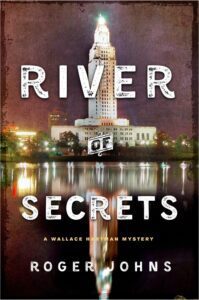
My initial reaction was to look inward, to wonder what I could have done different, that might have changed that outcome and improve my chances for future publication. After some contemplation, I decided to focus on the most important things over which I had the greatest control—what I was writing and how I was writing it. In other words, my story-telling and my prose-styling.
So, I reread my books, identified areas where I felt my writing could stand some improvement, then I decided to take on those shortcomings, one at a time. And the most efficient way I could think of to do that was to use the short story format—to devote at least one story to improving each of the areas that needed work. For me, this was a terrifying prospect, because writing short was not something I felt comfortable with. My history as an academic, and as a corporate attorney before that, had accommodated my natural long-windedness. But, short stories? Well…that was like watching a magic trick. I could see what the writer had done, but not how they had done it.
Unable to think of a better way, I identified, then read, then reread quite a few short stories that seemed to do well the things I most needed to learn. I was looking for the techniques hidden behind the veneer of engagement the authors had created—the sleight of hand behind the flash of illusion. After several readings, the stories ceased to entertain me and began to instruct me, and that gave me the nerve to try writing them on my own.
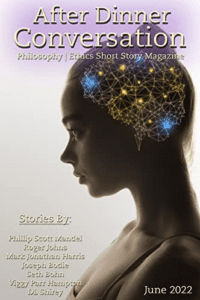
My first few stories were crime fiction, which didn’t surprise me. But it wasn’t long until I found that some of the things I needed to learn were best learned by attempting to write in new genres, and that did surprise me. Over the past couple of years, I’ve managed to publish a few science fiction pieces, along with some horror, and even one with strong romantic elements. And I’ve got several more, out on submission, that fall into the categories of science fiction, magical realism, and folk horror. Each attempt has helped me discover some new tools and to sharpen some old ones, but it took stepping out of my comfort zone and plowing new fields to get there. So, while I feel certain I’ll always write mysteries, I’m equally certain that it’s not always a mystery I’ll be writing.
ROGER JOHNS is a former corporate attorney, a retired college professor, and the author of the Wallace Hartman Mysteries, Dark River Risingand River of Secrets, from St. Martin’s Press. He is the 2018 Georgia Author of the Year (Detective·Mystery Category), a two-time Finalist for Killer Nashville’s Silver Falchion Award, and runner-up for the 2019 Frank Yerby Fiction Award. His short stories have been published by, among others, Saturday Evening Post, Alfred Hitchcock’s Mystery Magazine, Mystery Weekly Magazine, Dark City Crime & Mystery Magazine, After Dinner Conversation: The Philosophy & Ethics Short Story Magazine, and JOURN-E: The Journal of Imaginative Literature. Roger’s articles and interviews about writing and career management for new authors appear in Southern Literary Review, Writer Unboxed, Career Authors, and Southern Writers Magazine. Website: www.rogerjohnsbooks.com. Blog: www.murder-books.com.
The post The Long and the Short of It by Roger Johns first appeared on Debra H. Goldstein.
The post The Long and the Short of It by Roger Johns appeared first on Debra H. Goldstein.
October 9, 2023
A Beach Bum’s Journey to Becoming an Author by George Cramer
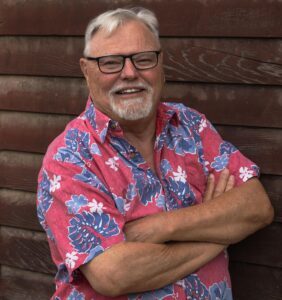 Until my late sixties, I never thought of writing fiction, let alone a novel.
Until my late sixties, I never thought of writing fiction, let alone a novel.
In high school, I rarely did homework; with a few exceptions, I could score Cs on most tests. The exception was Latin. Mr. Jung inspired me to work on translations and understanding the dead language. I've forgotten it all. My English grades were not stellar in college, but I have an excuse. I was living in a beach house with three buddies from high school. Vietnam was going hot and heavy, and we were in school to postpone the draft. In two years, I never saw any of us doing homework.
The Navy snatched me up.
Two years, nine months, and two days later, I left the Navy and joined a police department. After the police, I was an investigator for three decades. I wrote formalized reports based on the facts. As the famous Sergeant Joe Friday said, "The facts, mam, nothing but the facts."
When I turned sixty-eight, I was laid off from a great job due to a corporate buyout. This is when I came to know a great deal about age discrimination. I took a writing class at my senior center to upgrade my resume. It turned out to be a fiction writing class. I fell in love with writing fictional stories.
Desiring additional skills, I joined a writers' group where my brother and sister writers shared much with me and helped improve my craft. Later I joined Sisters in Crime, where my siblings taught me even more as they welcomed me with open arms.
Needing to further improve my craft and clear my mind of crime reports, I enrolled in English classes at the local community college—becoming a straight-A student. An enrolled descendant of the Karuk Tribe of California, I took a break to earn an MFA-Creative Writing from the Institute of American Indian Arts.
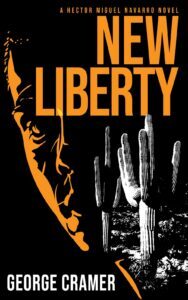
As a corporate and private Investigator, I conducted thousands of investigations throughout the Americas and Asia. Before Covid, I kept my investigative skills honed by volunteering as a property and Missing Person investigator at a Bay Area Police Department.
My short stories and poems have been published in numerous anthologies. The Mona Lisa Sisters was indie published in 2020, Robbers and Cops in 2022, and New Liberty, Book 1 in the Hector Miguel Navarro detective series, was released in May of this year.
Membership in the following groups has been a force multiplier in improving my craft: Sisters in Crime, Crime Writers of Color, Mystery Writers of America, and the California Writers Club.
~ ~ ~ ~ ~
George Cramer, an enrolled descendant of the Karuk Tribe of California, began his forty-year investigative career in law enforcement and then moved into private and corporate investigations.
As a corporate and private Investigator, Mr. Cramer conducted thousands of investigations throughout the Americas and Asia. He kept his investigative skills honed by volunteering as a Missing Person investigator at a California Police Department.
Contact Links:
Website: https://gdcramer.com
Blog: https://gdcramer.com/george-cramer-blog/
The post A Beach Bum’s Journey to Becoming an Author by George Cramer first appeared on Debra H. Goldstein.
The post A Beach Bum’s Journey to Becoming an Author by George Cramer appeared first on Debra H. Goldstein.
September 25, 2023
THE FIFTY-FIVE-YEAR PLAN by Josh Pachter
 My first short story appeared in Ellery Queen’s Mystery Magazine in 1968. Since then, I’ve been fortunate enough to sell over a hundred more to EQMM, Alfred Hitchcock’s Mystery Magazine, and many other periodicals and anthologies, and the Short Mystery Fiction Society awarded me its Golden Derringer for Lifetime Achievement in 2020.
My first short story appeared in Ellery Queen’s Mystery Magazine in 1968. Since then, I’ve been fortunate enough to sell over a hundred more to EQMM, Alfred Hitchcock’s Mystery Magazine, and many other periodicals and anthologies, and the Short Mystery Fiction Society awarded me its Golden Derringer for Lifetime Achievement in 2020.
Despite this long history of writing and selling short crime stories, though, it wasn’t until this month—fifty-five years after my debut—that Dutch Threat, my first full-length work of fiction, was published by Genius Book Publishing.
Why did it take me so long to write a novel?
That question will be harder for me to answer than it was to ask, and my response breaks down into five sub-answers:
Time. I’ve been teaching at the college level for almost as long as I’ve been writing professionally, and my career in education—combined with writing and translating short stories, editing almost two dozen anthologies, and my responsibilities as a husband and father—has kept me kinda busy. When I retired from full-time teaching last fall, I suddenly found myself with more free time than I’d grown accustomed to having.
Attention Span. It takes me anywhere from a day or two to a month or two to write a short story, where I saw that it would take me well over a year to write a novel … and, frankly, I’ve never felt confident that I could stay focused on a single project for that long.
Readership. When I sell a short story to EQMM, I know that it will be read by thousands of people, but the typical novel (and by “typical” I mean “not written by James Patterson or Michael Connelly”) will attract a significantly smaller number of readers.
Variety. Writing a novel means spending a year or more delving into the lives of a single cast of characters, a single basic setting, a single plot. In that same year, I can write a dozen short stories, which gives me the opportunity to explore a dozen casts of characters, a dozen settings, a dozen plots.
Marketing knowledge. I have over time developed a pretty good sense of the marketplace for short crime fiction, and I know even before I begin to write a short story where I’ll have the best shot at selling it. I know nothing, however, about selling a novel—and it’s always seemed counterproductive to me to devote a year to writing a single work that I have no idea how to sell.
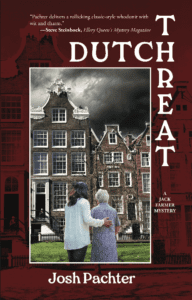
How, then, did Dutch Threat happen? Well, I came up with an idea for a work of fiction about several murders in a closed community in the heart of Amsterdam, a city in which I lived for about six years in the 1980s, and the concept just seemed too complicated for a short story. I started writing—and, before I knew it, I found myself writing a novel, after all.
Then, completely coincidentally, Stephen and Leya Booth at Genius reached out to me—based on a recommendation from terrific short-story author David Dean—and asked if I might by any chance have a novel that was looking for a publisher … and, I’ll be darned, I did!
As things turned out, the process of writing and then finding a home for Dutch Threat wasn’t nearly as daunting as I expected it to be, and the early reviews and sales figures have been very encouraging.
So who knows, perhaps I’ll start writing a novel every fifty-five years!
JOSH PACHTER was the 2020 recipient of the Short Mystery Fiction Society’s Golden Derringer for Lifetime Achievement. His stories appear in Ellery Queen’s Mystery Magazine, Alfred Hitchcock’s Mystery Magazine, and elsewhere. He edits anthologies (including Anthony Award finalists The Beat of Black Wings: Crime Fiction Inspired by the Songs of Joni Mitchell and Paranoia Blues: Crime Fiction Inspired by the Songs of Paul Simon) and translates fiction and nonfiction from multiple languages—mainly Dutch—into English.
DUTCH THREATAll work and no play might well make Jack a dull boy. But when one of his professors offers to send American grad student Jack Farmer to Europe to do historical research in Amsterdam's Begijnhof—a peaceful closed community in the heart of the bustling Dutch capital—Jack looks forward to a summer of mostly play and not much work. Then he meets Jet Schilders, an attractive young nurse who takes care of the elderly woman next door, and realizes that his summer in The Netherlands might just turn out to be even more fun than he’d hoped.
When the woman next door is brutally murdered, though, and her nurse turns out to be the prime suspect, Jack and Jet join forces in an attempt to find the real killer and clear her name. But their investigation puts them in Dutch with the local police, and a second murder raises the stakes ... and paints a target on both of their backs.
PURCHASE LINKSDirect from the publisher: https://geniusbookpublishing.com/collections/light-fiction/products/dutch-threat
Amazon: https://www.amazon.com/Dutch-Threat-Josh-Pachter/dp/B0CHDLCM2H
Barnes & Noble: https://www.barnesandnoble.com/w/books/1144044470?ean=9781958727140
The post THE FIFTY-FIVE-YEAR PLAN by Josh Pachter first appeared on Debra H. Goldstein.
The post THE FIFTY-FIVE-YEAR PLAN by Josh Pachter appeared first on Debra H. Goldstein.
September 11, 2023
We Must Remember by Debra H. Goldstein
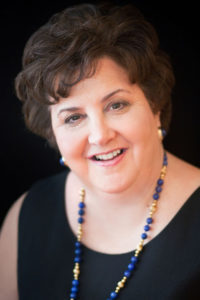 Twenty-two years have passed since September 11, 2001. Twenty-two years since terrorists hijacked four airplanes to carry out suicide attacks in the United States. Almost 3000 people were killed and even more had their lives and families forever disrupted.
Twenty-two years have passed since September 11, 2001. Twenty-two years since terrorists hijacked four airplanes to carry out suicide attacks in the United States. Almost 3000 people were killed and even more had their lives and families forever disrupted.
Many of us remember where we were when two planes hit the Twin Towers of the World Trade Center in New York. We remember reacting when told a plane had crashed into the Pentagon. Together, we mourned and praised the bravery of the passengers who revolted on a fourth plane, causing it to crash in rural Pennsylvania rather than reaching its target of the United States Capitol or White House.
Twenty-two years have passed, but we remember. We must remember.
The post We Must Remember by Debra H. Goldstein first appeared on Debra H. Goldstein.
The post We Must Remember by Debra H. Goldstein appeared first on Debra H. Goldstein.
August 29, 2023
2023 Silver Falchion Best Book by an Attending Author
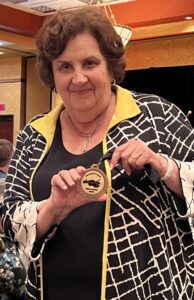 Debra was presented the 2023 Killer Nashville Silver Falchion Best Book by an Attending Author for Five Belles Too Many during the August 19, 2023 Killer Nashville Awards Banquet.
Debra was presented the 2023 Killer Nashville Silver Falchion Best Book by an Attending Author for Five Belles Too Many during the August 19, 2023 Killer Nashville Awards Banquet.
The post 2023 Silver Falchion Best Book by an Attending Author first appeared on Debra H. Goldstein.
The post 2023 Silver Falchion Best Book by an Attending Author appeared first on Debra H. Goldstein.
August 28, 2023
What Preoccupies Us as Writers Keeps Showing Up by Lynn Slaughter
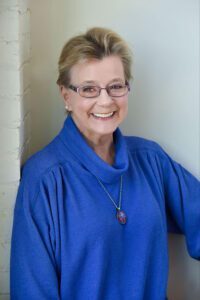
The first time someone asked me to present a workshop on writing for young adults, I prepared not only by mining my own experiences as a YA mystery writer, but by reading extensively on the subject. A couple of themes emerged again and again: Young adult readers are above all concerned with the emotional journey of characters, their growth and transformation, and treasure some semblance of hope at the end that things can, or will, get better in the future.
Aha, I thought. No wonder I’ve been so strongly drawn to writing for this age group. I’m fascinated by the dramatic emotional journey that transpires during adolescence. On the cusp of adulthood, teens are trying to figure out fundamental questions of identity: Who am I, and who do I want to become? Where do I fit? And how do I achieve agency in my own life?
Often, this involves differentiating from parents who have definite scripts in mind for their children. In my novel, LEISHA’S SONG, for example, Leisha’s grandfather, the only parent she’s ever known, wants her to pursue medicine rather than music and certainly doesn’t want her to get involved with Cody, a sensitive cellist from a conservative white family. By the end of the novel, Leisha hasn’t just solved the mystery of her missing teacher, but she has also stood up to her grandfather, insisting upon pursuing her own dreams and the boy she cares about. Having spent her life as a pleaser who genuinely loves her grandfather, this is hard for Leisha. But it’s a transition that’s necessary to give her any hope for a future that’s a good fit for who she is and who she dreams of becoming.
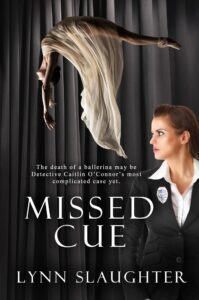
What does this have to do with my first adult mystery, MISSED CUE, which came out earlier this month? What preoccupies me as a writer is apparent, regardless of what age group I’m writing for. Obviously, I love mysteries, but the similarities go well beyond that. My protagonist in MISSED CUE, homicide detective Caitlin O’Connor, also has some personal growth and maturing to do. While dealing with the most complicated case of her career, the suspicious onstage death of a revered ballerina, she’s involved in a relationship with the very married medical examiner. Despite the guilt she experiences, getting involved with married, ultimately unavailable men is a long-standing pattern for her. She finally goes into therapy to figure out why. Not surprisingly, she discovers some answers in emotional baggage she’s carried dating back to childhood.
By the end of the novel, Caitlin has not only solved the case but is on her way to a healthier relationship with herself. In other words, there is hope for a better future for her personally, as well as professionally.
The thing about writing is that you take yourself and your preoccupations and pour them into whatever you’re working on. That may be why I’ve had such a tough time responding to questions about the differences between writing for young adults and adults. At any age, we can always mature and grow and move toward a more hopeful future. And that’s the stuff that interests me above all.
Lynn Slaughter is addicted to the arts, chocolate, and her husband’s cooking. After a long career as a professional dancer and dance educator, Lynn earned her MFA in Writing Popular Fiction from Seton Hill University. Her first mystery for adults, MISSED CUE, recently came out from Melange Books. She is also the author of four award-winning young adult romantic mysteries: DEADLY SETUP, LEISHA’S SONG, IT SHOULD HAVE BEEN YOU, AND WHILE I DANCED. Lynn lives in Louisville, Kentucky, where she’s at work on her next novel, serves on the board of Louisville Literary Arts, and is an active member and former president of Derby Rotten Scoundrels, the Ohio River Valley chapter of Sisters in Crime.
Contact/Buy Links:
Available at:
Amazon
Barnes & Noble
iBooks
Kobo
Smashwords
The post What Preoccupies Us as Writers Keeps Showing Up by Lynn Slaughter first appeared on Debra H. Goldstein.
The post What Preoccupies Us as Writers Keeps Showing Up by Lynn Slaughter appeared first on Debra H. Goldstein.
August 14, 2023
One Size Does Not Fit All by Lois Winston
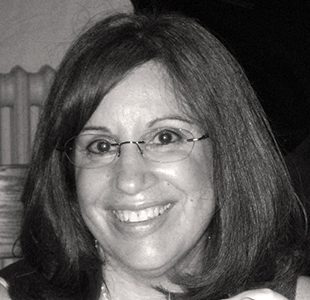 A Crafty Collage of Crime, the twelfth book in my Anastasia Pollack Crafting Mystery Series, released this past June. I’ve spent much of the summer in promo mode, mostly on blog tours, podcasts, and Zoom events. At the end of this week, I’ll be attending Killer Nashville with Debra, many other authors, and those wishing to become published authors. A question that both readers and aspiring authors often ask me is how long it takes to write a book. Writing isn’t accounting. Although two plus two will always equal four, there are far too many factors that go into writing a novel for there to be a single answer to that question.
A Crafty Collage of Crime, the twelfth book in my Anastasia Pollack Crafting Mystery Series, released this past June. I’ve spent much of the summer in promo mode, mostly on blog tours, podcasts, and Zoom events. At the end of this week, I’ll be attending Killer Nashville with Debra, many other authors, and those wishing to become published authors. A question that both readers and aspiring authors often ask me is how long it takes to write a book. Writing isn’t accounting. Although two plus two will always equal four, there are far too many factors that go into writing a novel for there to be a single answer to that question.
Truthfully, I wrote much faster when I had no clue how to write a publishable book. My first novel took me only a few weeks to complete. It was a 50,000-word romance that spanned thirty-five years. I thought I’d written the great American novel, or at least the next bestselling romance—until the rejection letters started shooting through my mail slot. (This was back in the days of snail mailed queries and rejection letters.)
Once I learned everything I was doing wrong and how to “write right,” the writing process took much longer. These days, depending on whether my muse is cooperating, and the stars are properly aligned regarding everything else in my life, it takes me anywhere from eight months to a year to write a book, sometimes longer. This seems to be the case for most authors I know. However, some authors write faster, and some take several years to write each book.
Nothing about writing is one-size-fits-all. One of the things a writer learns in her journey toward publication is that we all must find the process that works best for us. For example, some writers need to outline every scene in each chapter before they start writing that first sentence. Others fly by the seat of their pants, allowing the story and characters to control the journey. Some write multiple drafts; others revise as they go. What works well for one author won’t necessarily work for another because, as I said above, writing isn’t like accounting.
Learning to write is very much trial and error. Not only do you need to develop plots, subplots, and characters that will hold a reader’s attention from the first page to the last, but you also need to develop a unique voice and writing style.
It can take years of writing and rewriting before your novel is ready for prime time. I wrote for ten years before I sold my first book in 2005. The second book I sold was that 50,000-word romance that spanned thirty-five years. After years of developing the skills I needed to write publishable fiction, that unpublishable romance had been revised into a 90,000-word award-winning romantic suspense that took place over the course of a few months. Since then, I’ve published twenty-one novels, five novellas, and several short stories.
My writing journey is far from unique. Very few authors find overnight success. For most of us, the distance between committing that first word to paper (or computer screen) and holding your first published book in your hand is a marathon, not a sprint.
A Crafty Collage of CrimeAn Anastasia Pollack Crafting Mystery, Book 12
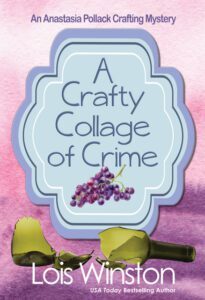
Wherever crafts editor and reluctant amateur sleuth Anastasia Pollack goes, murder and mayhem follow. Her honeymoon is no exception. She and new husband, photojournalist (and possible spy) Zachary Barnes, are enjoying a walk in the Tennessee woods when they stumble upon a body on the side of a creek. The dead man is the husband of one of the three sisters who own the winery and guest cottages where Anastasia and Zack are vacationing.
When the local sheriff sets his sights on the widow as the prime suspect, her sisters close ranks around her. The three siblings are true-crime junkies, and thanks to a podcaster who has produced an unauthorized series about her, Anastasia’s reputation for solving murders has preceded her to the bucolic hamlet. The sisters plead for her help in finding the real killer. As Anastasia learns more about the women and their business, a host of suspects emerge, including several relatives, a relentless land developer, and even the sisters themselves.
Meanwhile, Anastasia becomes obsessed with discovering the podcaster’s identity. Along with knowing about Anastasia’s life as a reluctant amateur sleuth, the podcaster has divulged details of Anastasia’s personal life. Someone has betrayed Anastasia’s trust, and she’s out to discover the identity of the culprit.
Craft project included.
Amazon: https://amzn.to/3NX6O13
Kobo: https://www.kobo.com/us/en/ebook/a-crafty-collage-of-crime
Barnes & Noble: https://www.barnesandnoble.com/w/a-crafty-collage-of-crime-lois-winston/1143442079?ean=2940161008225
Apple Books: https://books.apple.com/us/book/a-crafty-collage-of-crime/id6448801378
USA Today and Amazon bestselling author Lois Winston began her award-winning writing career with Talk Gertie to Me, a humorous fish-out-of-water novel about a small-town girl going off to the big city and the mother who had other ideas. That was followed by the romantic suspense Love, Lies and a Double Shot of Deception.
Then Lois’s writing segued into the world of amateur sleuths with her humorous Anastasia Pollack Crafting Mystery Series, which Kirkus Reviews dubbed “North Jersey’s more mature answer to Stephanie Plum.” The series now includes twelve novels and three novellas.
To date Lois has published twenty-one novels, five novellas, several short stories, one children’s chapter book, and one nonfiction book on writing.
Website:http://www.loiswinston.com
Newsletter sign-up: https://landing.mailerlite.com/webforms/landing/r2e9v1
Killer Crafts & Crafty Killers blog: www.anastasiapollack.blogspot.com
Pinterest: www.pinterest.com/anasleuth
Twitter: https://twitter.com/Anasleuth
Goodreads: https://www.goodreads.com/author/show/722763.Lois_Winston
Bookbub: https://www.bookbub.com/authors/lois-winston
The post One Size Does Not Fit All by Lois Winston first appeared on Debra H. Goldstein.
The post One Size Does Not Fit All by Lois Winston appeared first on Debra H. Goldstein.



